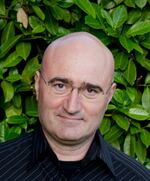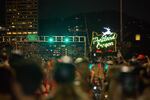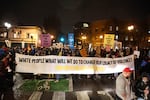The ongoing protests for racial justice in Portland have caught the attention of the nation. Longtime Portlanders, however, aren’t all that surprised that people are taking to the streets in this way. We have a history of it, and that’s kind of by design.

Jarrett Walker
Picasa
Author and urban planning consultant Jarrett Walker has lived in Portland since 1969. He says the way Portland’s urban core is laid out makes it protest-friendly.
“There is something about Portland here that we should celebrate,” Walker says. “And that is something about the shape of the city and how it has developed that makes this possible.”
Portland’s city blocks are shorter, for example, which make the spectacular — and intimidating — skyscrapers of other cities impossible to build. City planners also worked to make Portland more pedestrian-friendly, which makes it easier to stage mass demonstrations on foot.
Walker talked about planning, protests and what they mean for Portland’s celebrated livability with Morning Edition host Geoff Norcross.
Norcross: “You put a thread on Twitter about the way Portland’s urban core is laid out and how that lends itself to gatherings like these demonstrations. Can you make that connection for me?”
Walker: "Sure, and honoring all of the burning issues that these demonstrations are dealing with and the urgent problems that they’re raising and the very painful history that they’re telling about our city and about Oregon. I also think, though, that there is something about Portland here that we should celebrate, and that is something about the shape of the city and how it has developed that makes this possible.
"In the 1970s, I was a teenager living here, and I was a misfit. I was gay at a time when you only talked about that in horrified whispers. I was an intellectual. I was very introverted. I didn’t fit in. I would go back and forth between Portland and Seattle, and I came upon the thought that Portland is, by its nature, enclosing and nurturing. And Seattle is, by comparison, challenging and intimidating. And I think there are two things going on there.
"There’s the natural geography. Portland is in a valley which encloses us. Seattle is all promontories and cliffs thrusting us out into space. And there’s a very technical thing that planners will notice but that’s subliminally affecting everyone. Seattle’s blocks are 20% longer, and that turns out to be a very technical description of how Seattle manages to feel more intimidating and Portland more intimate because, for example, it permits Seattle to build bigger, taller, more intimidating buildings than possible on the smaller blocks in Portland. So this is part of, I think, why, if you’re asking about Seattle and you’ll tend to hear the word ‘spectacular,’ when in Portland, you’ll hear the word ‘intimate.’ And I think that to me, as a misfit kid, that I felt like the city was embracing and supporting me in some way, and I felt the opposite in Seattle.
“I can’t help but relate that to Portland’s history of being a relatively safe place to be weird and different, which has become so fundamental to our identity. And then because you have so many people who are comfortable with being different, you have the kind of idealism, that willingness to challenge the whole way that the world is, which is natural if you’ve grown up as somebody who feels rejected by the world.”

A jogger runs along the waterfront in Gov. Tom McCall Waterfront Park in downtown Portland, Ore., on Tuesday, June 23, 2020. The park, named after Oregon's famous environmentalist former governor, sits where a highway once ran.
Bryan M. Vance / OPB
Norcross: “I guess we’re talking about the `60s and maybe the early `70s when all of these changes came around in Portland. Did the city leaders purposely set out to make a city that felt welcoming to somebody like you?”
Walker: "Yes, of course. The 1970s, when I was a teenager, was really the decade in which the battleship was turned and pointed in a new direction. The city went about very intentionally making this the city for pedestrians and making it more of a place to walk instead of a place to drive. That continues today and has helped to engender the subsequent cycling revolution that we’re also famous for.
"But here’s the essence of it and how this comes back to protest. To be a pedestrian is to be vulnerable, is to be in some danger from cars. It’s the opposite of what you see in the suburbs where everyone is in a tank and you have this arms race of ever more aggressive SUVs, wherein people feel safer. The pedestrian is vulnerable. And I relate that to the celebration of vulnerability that we see in our style of protest.
“Think about the role of nudity in protests in Portland: the naked bike ride, the famous woman in the protests who walked up to the officers naked and that celebration of vulnerability, that willingness to recognize our central vulnerability and actually put it forward as a challenge to authority. I think it all comes back to that. This is a safer place to be vulnerable.”

A sea of butts.
Bradley W. Parks / OPB
Norcross: “Yes, but of course, there’s the question when you bring in Portland’s troubled history with racism. When the planners were building the city to be more inclusive and welcoming and safe, did they have everybody in mind?”
Walker: "They never have everybody in mind. As someone who works in planning, we who do this are all part of an economic structure that is selling livability to the world. Livability is the thing we’re famous for, it’s our product. We have people going around the world, giving presentations about how wonderful Portland is, on how brilliantly it’s planned. Livability is, however, a product with a market. The market is people who have the opportunity to choose what cities to invest in. Those people tend to be wealthy, and they tend to be white. I think, then, that we have a healthy and necessary tension between the brute fact that, in a capitalist system, that’s how investment happens, and the fact that we have a large share of the population in open and healthy rebellion against that system.
“Ironically, through our livability, through the way we’ve built the city, we’ve created both the stage on which those protests can express themselves effectively, but also attracted the kinds of people who are inclined to protest, who already see themselves to be as rejected by the system and want to stand up to it.”
Norcross: “In some of the coverage of the current protests, writers have brought up Portland’s celebrated livability as if it’s something that doesn’t exist anymore because of all this protest activity. What do you think about that idea, that livability and protest can’t exist at the same time?”
Walker: “If livability is a marketing slogan, and if part of the subliminal message of livability is that if you live here history won’t happen to you, if what we’re doing is selling livability to people from the suburbs and by implicitly promising that the kind of expectations you have about society living in the suburbs will apply here, then no, that’s not the livability we offer anymore. But the joy of a city, the whole reason to live in the city, is the unpredictable, is that you can’t expect to be protected from history happening around you. And I think that what is happening in Portland is so wonderful. It’s horrible, and it’s also wonderful because it is helping us to bring together and include in our concept of livability the reality that, yes, the institutional structures that we live under are horrible and objectionable, and this is a relatively safe place to express that.”
Norcross: “I’m wondering how the protest activity this summer has changed your thinking and your relationship with your city that you’ve lived in for over 50 years, if at all.”
Walker: “I have not been surprised by the protests. If you don’t know much history, it’s easy to think that the violence around the edges of the protests is shocking and is not the Portland way of doing things. But if you study the history of protest, there’s been plenty of that. I rode my parents' shoulders in 1970 through demonstrations against the Vietnam War. There was violence around the edges of those. That’s not new. What is new and glorious is that seriously excluded populations, especially Black people, are seizing their place in the city and demanding their place in the community. And that’s wonderful.”

Protesters stand behind a large banner at the west end of the Burnside Bridge on Jan. 20, 2017.
Amelia Templeton / OPB
To listen to this conversation, use the audio player at the top of this story.
